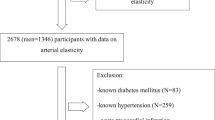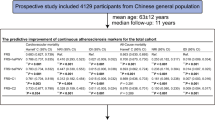Abstract
The assessment of cardiovascular risk is uniformly recommended as a decision-support for therapies aimed at preventing cardiovascular diseases. Our objective was to determine the prognostic significance of vascular markers in apparently healthy subjects. Analyses were based on the Third Toulouse MONICA Survey (1995–1997) carried out in participants aged 35–64, from the general population of South-western France. Causes of death were obtained 14 years after inclusion. There were 1132 participants (51% men). Over the 14-year follow-up period, 61 deaths were recorded, 20% due to a cardiovascular cause. Adding pulse wave velocity (PWV) to Framingham Risk Score (FRS) improved the accuracy of the risk prediction model. The C-statistic increased from 0.76 (95% confidence interval (CI): 0.64–0.89) (FRS alone) to 0.79 (95% CI: 0.64–0.95) (FRS+PWV). The Integrated Discrimination Improvement (IDI) reached 3.81% (P-value<0.001) and the net reclassification improvement (NRI) was equal to 32%. Risk prediction was also improved by integrating pulse pressure (PP) in the model (C-statistic=0.81 (95% CI: 0.66–0.96); IDI=4.99% (P-value<0.001); NRI=30%) or the number of carotid or femoral atherosclerotic plaques (C-statistic=0.78 (95% CI: 0.63–0.93); IDI=2.21% (P-value<0.001); NRI=21%). Vascular markers are independent determinants of cardiovascular mortality in apparently healthy subjects and improve risk prediction.
This is a preview of subscription content, access via your institution
Access options
Subscribe to this journal
Receive 12 digital issues and online access to articles
$119.00 per year
only $9.92 per issue
Buy this article
- Purchase on Springer Link
- Instant access to full article PDF
Prices may be subject to local taxes which are calculated during checkout

Similar content being viewed by others
References
Wilson PW, D’Agostino RB, Levy D, Belanger AM, Silbershatz H, Kannel WB . Prediction of coronary heart disease using risk factor categories. Circulation 1998; 97: 1837–1847.
European Society of Cardiology. Fourth Joint Task Force of the European Society of Cardiology and Other Societies on Cardiovascular Disease Prevention in Clinical Practice. European guidelines on cardiovascular disease prevention in clinical practice: executive summary. Eur Heart J 2007; 28: 2375–2414.
2010 ACCF/AHA Guideline for Assessment of Cardiovascular Risk in Asymptomatic Adults: Executive Summary. A report of the American College of Cardiology Foundation/American Heart Association Task Force on Practice Guidelines. Circulation 2010; 122: 2748–2764.
Cao JJ, Arnold AM, Manolio TA, Polak JF, Psaty BM, Hirsch CH et al. Association of carotid artery intima-media thickness, plaques, and C-reactive protein with future cardiovascular disease and all-cause mortality: the Cardiovascular Health Study. Circulation 2007; 116: 32–38.
Lorenz MW, Markus HS, Bots ML, Rosvall M, Sitzer M . Prediction of clinical cardiovascular events with carotid intima-media thickness: a systematic review and meta-analysis. Circulation 2007; 115: 459–467.
Novo S, Carità P, Corrado E, Muratori I, Pernice C, Tantillo R et al. Preclinical carotid atherosclerosis enhances the global cardiovascular risk and increases the rate of cerebro- and cardiovascular events in a five-year follow-up. Atherosclerosis 2010; 211: 287–290.
Simon A, Megnien JL, Chironi G et al. The value of carotid intima-media thickness for predicting cardiovascular risk. Arterioscler Thromb Vasc Biol 2010; 30: 182–185.
Vlachopoulos C, Aznaouridis K, Stefanadis C et al. Prediction of cardiovascular events and all-cause mortality with arterial stiffness: a systematic review and meta-analysis. J Am Coll Cardiol 2010; 55: 1318–1327.
Muiesan ML, Salvetti M, Paini A, Monteduro C, Rosei CA, Aggiusti C et al. Pulse wave velocity and cardiovascular risk stratification in a general population: the Vobarno study. J Hypertens 2010; 28: 1935–1943.
Madhavan S, Ooi WL, Cohen H, Alderman MH . Relation of pulse pressure and blood pressure reduction to the incidence of myocardial infarction. Hypertension 1994; 23: 395–401.
Benetos A, Rudnichi A, Safar M, Guize L . Pulse pressure and cardiovascular mortality in normotensive and hypertensive subjects. Hypertension 1998; 32: 560–564.
Verdecchia P, Schillaci G, Reboldi G, Franklin SS, Porcellati C . Different prognostic impact of 24-hour mean blood pressure and pulse pressure on stroke and coronary artery disease in essential hypertension. Circulation 2001; 103: 2579–2584.
Mattace-Raso FU, van der Cammen TJ, Hofman A, van Popele NM, Bos ML, Schalekamp MA et al. Arterial stiffness and risk of coronary heart disease and stroke: the Rotterdam Study. Circulation 2006; 113: 657–663.
Nambi V, Chambless L, Folsom AR, He M, Hu Y, Mosley T et al. Carotid intima-media thickness and the presence or absence of plaque improves prediction of coronary heart disease risk in the Atherosclerosis Risk in Communities (ARIC) study. J Am Coll Cardiol 2010; 55: 1600–1607.
Sehestedt T, Jeppesen J, Hansen TW, Wachtell K, Ibsen H, Torp-Pedersen C et al. Risk prediction is improved by adding markers of subclinical organ damage to SCORE. Eur Heart J 2010; 31: 883–891.
Baldassarre D, Hamsten A, Veglia F, de Faire U, Humphries SE, Smit AJ et al IMPROVE Study Group. Measurements of carotid intima-media thickness and of interadventitia Common Carotid Diameter Improve Prediction Of Cardiovascular Events: results of the IMPROVE (carotid intima media thickness [IMT] and IMT-progression as Predictors Of Vascular Events in a High Risk European Population) Study. J Am Coll Cardiol 2012; 60: 1489–1499.
Yeboah J, McClelland RL, Polonsky TS, Burke GL, Sibley CT, O'Leary D et al. Comparison of novel risk markers for improvement in cardiovascular risk assessment in intermediate-risk individuals. JAMA 2012; 308: 788–795.
Den Ruijter HM, Peters SA, Anderson TJ, Britton AR, Dekker JM, Eijkemans MJ et al. Common carotid intima-media thickness measurements in cardiovascular risk prediction: a meta-analysis. JAMA 2012; 308: 796–803.
Kavousi M, Elias-Smale S, Rutten JH, Leening MJ, Vliegenthart R, Verwoert GC et al. Evaluation of newer risk markers for coronary heart disease risk classification: a cohort study. Ann Intern Med 2012; 156: 438–444.
Kuulasmaa K, Tunstall-Pedoe H, Dobson A, Fortmann S, Sans S, Tolonen H et al. Estimation of contribution of changes in classic risk factors to trends in coronary-event rates across the WHO MONICA Project populations. Lancet 2000; 355: 675–687.
Marques-Vidal P, Ruidavets JB, Amouyel P, Ducimetière P, Arveiler D, Montaye M et al. Change in cardiovascular risk factors in France, 1985-1997. Eur J Epidemiol 2004; 19: 25–32.
Ferrières J, Cambou JP, Ruidavets JB, Pous J . Trends in acute myocardial infarction prognosis and treatment in southwestern France between 1985 and 1990 (the MONICA Project-Toulouse). Am J Cardiol 1995; 75: 1202–1205.
INSERM—IFR69. Mise en oeuvre du décret n_ 98-37 autorisant l’accès aux données relatives au décès des personnes inscrites au Répertoire National d’Identification des Personnes Physiques (RNIPP) dans le cadre des recherches dans le domaine de la santé http://ifr69.vjf.inserm.fr/svcd.html 19 October 2012.
Friedewald WT, Levy RI, Fredrickson DS . Estimation of the concentration of low density lipoprotein cholesterol in plasma without use of the preparative ultracentrifuge. Clin Chem 1978; 18: 499–502.
van Popele NM, Grobbee DE, Bots ML, Asmar R, Topouchian J, Reneman RS et al. Association between arterial stiffness and atherosclerosis. The Rotterdam study. Stroke 2001; 32: 454–460.
Touboul PJ, Prati P, Scarabin PY, Adrai V, Thibout E, Ducimetière P . Use of monitoring software to improve the measurement of carotid wall thickness by B-mode imaging. J Hypertens 1992; 10 (Suppl. 5): S37–S41.
Asmar R, Benetos A, Topouchian J, Laurent P, Pannier B, Brisac AM et al. Assessment of arterial distensibility by automatic pulse wave velocity measurement. Validation and clinical application studies. Hypertension 1995; 26: 485–490.
Fine J, Gray R . A proportional hazards model for the subdistribution of a competing risk. J Am Stat Assoc 1999; 94: 496–509.
Pencina MJ, D’Agostino RB, D’Agostino RB, Vasan RS . Evaluating the added predictive ability of a new marker: from area under the ROC curve to reclassification and beyond. Stat Med 2008; 27: 157–172.
Pencina MJ, D’Agostino RB, Steyerberg EW et al. Extensions of net reclassification improvement calculations to measure usefulness of new biomarkers. Stat Med 2011; 30: 11–21.
Perk J, De Backer G, Gohlke H, Graham I, Reiner Z, Verschuren M et al. European Guidelines on cardiovascular disease prevention in clinical practice (version 2012). Eur Heart J 2012; 33: 1635–1701.
Conroy RM, Pyörälä K, Fitzgerald AP, Sans S, Menotti A, De Backer G et al SCORE project group. Estimation of ten-year risk of fatal cardiovascular disease in Europe: the SCORE project. Eur Heart J 2003; 24: 987–1003.
Graham I, Atar D, Borch-Johnsen K, Boysen G, Burell G, Cifkova R et al. Fourth Joint Task Force of the European Society of Cardiology and Other Societies on Cardiovascular Disease Prevention in Clinical Practice. European guidelines on cardiovascular disease prevention in clinical practice: executive summary. Eur Heart J 2007; 28: 2375–2414.
Acknowledgements
We thank the ‘Institut National de la Santé et de la Recherche Médicale’ (INSERM), the ‘Direction Générale de la Santé (DGS)’, the ‘Institut Pasteur de Lille’, the ‘University Hospital of Lille’, the ‘Fonds d’intervention en Santé Publique’, the ‘Mutuelle Générale de l'Education Nationale’, ‘ONIVINS’, the ‘Fondation de France’, the ‘CPAM of Selestat’, the ‘Fédération Française de Cardiologie’, the ‘Conseil Régional du Nord-Pas de Calais’, Parke-Davis and Bayer pharmaceuticals, and CERIN for their financial supports enabling this work. We appreciate the collaboration with the INSEE and the health centres. We would also like to thank all investigators of the MONICA Project for their contribution to the compilation, validation and analysis of the data.
Disclaimer
The sponsors did not take part of interfere in data analysis or in the editiong of the manuscript.
Author information
Authors and Affiliations
Corresponding author
Ethics declarations
Competing interests
The authors declare no conflict of interest.
Additional information
Supplementary Information accompanies the paper on the Journal of Human Hypertension website
Supplementary information
Rights and permissions
About this article
Cite this article
Bérard, E., Bongard, V., Ruidavets, JB. et al. Pulse wave velocity, pulse pressure and number of carotid or femoral plaques improve prediction of cardiovascular death in a population at low risk. J Hum Hypertens 27, 529–534 (2013). https://doi.org/10.1038/jhh.2013.8
Received:
Revised:
Accepted:
Published:
Issue Date:
DOI: https://doi.org/10.1038/jhh.2013.8
Keywords
This article is cited by
-
Carotid stiffness and atherosclerotic risk: non-invasive quantification with ultrafast ultrasound pulse wave velocity
European Radiology (2019)
-
Incorporation of Novel Vascular Measures into Clinical Management: Recent Insights from the Framingham Heart Study
Current Hypertension Reports (2019)



